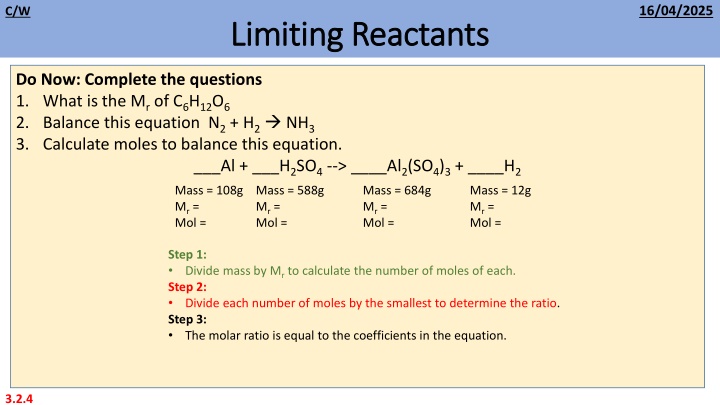
Limiting Reactants in Chemical Reactions
Learn about limiting reactants in chemical reactions, how to identify them, why they are crucial for reaction completion, and how to calculate them using examples and equations. Explore the concept of excess reactants and their impact on reactions.
Download Presentation

Please find below an Image/Link to download the presentation.
The content on the website is provided AS IS for your information and personal use only. It may not be sold, licensed, or shared on other websites without obtaining consent from the author. If you encounter any issues during the download, it is possible that the publisher has removed the file from their server.
You are allowed to download the files provided on this website for personal or commercial use, subject to the condition that they are used lawfully. All files are the property of their respective owners.
The content on the website is provided AS IS for your information and personal use only. It may not be sold, licensed, or shared on other websites without obtaining consent from the author.
E N D
Presentation Transcript
16/04/2025 C/W Limiting Reactants Limiting Reactants Do Now: Complete the questions 1. What is the Mr of C6H12O6 2. Balance this equation N2 + H2 NH3 3. Calculate moles to balance this equation. ___Al + ___H2SO4 --> ____Al2(SO4)3 + ____H2 Mass = 108g Mr = Mol = Mol = Mass = 588g Mr = Mass = 684g Mr = Mol = Mass = 12g Mr = Mol = Step 1: Divide mass by Mr to calculate the number of moles of each. Step 2: Divide each number of moles by the smallest to determine the ratio. Step 3: The molar ratio is equal to the coefficients in the equation. 3.2.4
16/04/2025 C/W Progress Indicators Progress Indicators Good progress: Explain why some reactants need to be used in excess to ensure a reaction goes to completion. Outstanding progress: Explain how to identify the limiting reactant in a reaction 3.2.4
16/04/2025 C/W Limiting Reactants Limiting Reactants Task: Calculate the minimum mass of hydrochloric acid (HCl) required to react with 50g of magnesium. 1 2 1 1 Mg (s) + 2 HCl (aq) MgCl2 (g) + H2(g) Mass = Mass = 50 g 24 g/mol 36.5 g/mol Mr = Mr = Q. What would happen if there was less hydrochloric acid than required? 2.1 mol 4.2 mol Mol = Mol = Not all of the magnesium would react! Mass = Mr x mol Mass = 35.5 g/mol x 4.2 mol = 153.3 g 153.3 g
Limiting Reactants Limiting Reactants If the number of moles of a reactant is less than the stoichiometric ratio tells us, then we would call this limiting reactant. The limiting reactant will limit how far the reaction goes. e.g. the reaction will not go to completion. The limiting reactant itself will be fully used up! The reaction will only go as far as the number of moles of the limiting reactant allows. We can calculate which reactant is limiting using mole equations.
Example: Limiting Reactants Example: Limiting Reactants In this equation, methane is reacted with oxygen to give a complete combustion reaction. CH4(g) + 2 O2 (g) CO2 (g) + 2 H2O (l) Mass = Mass = 64 g 16 g 16 g/mol In this ideal scenario we can see that for every 1 mol of methane, 2 moles of oxygen are required. Mr = Mr = 32 g/mol 1.0 mol Mol = 2.0 mol Mol = This equates to 64g oxygen for every 16 g of oxygen. Mass = Mr x mol Mass = 32 g/mol x 2.0 mol = 64 g But what if the air intake was blocked?
Example: Limiting Reactants & Excess Reactants Example: Limiting Reactants & Excess Reactants In this equation, methane is reacted with oxygen to give a complete combustion reaction. CH4(g) + 2 O2 (g) CO2 (g) + 2 H2O (l) 50 g Mass = Mass = 16 g 16 g/mol Mr = Mr = 32 g/mol 2.0 mol 1.0 mol 0.78 mol Mol = Mol = 1.56 mol We needed 2 moles but we actually only have 1.56 mol! 1.56 mol 2 = 0.78 mol. This means only 0.78 moles of methane can react, based on the 1:2 ratio. Oxygen is a limiting reagent and methane is in excess.
Task: Limiting & Excess Reactants Task: Limiting & Excess Reactants C3H8(g) + 5 O2 (g) 3 CO2 (g) + 4 H2O (l) a) Calculate the minimum mass of oxygen required to react with 120g of propane (C3H8). 436g Limiting, as it is less moles (12.5 mol) than is required by the 5:1 stoichiometric ratio (13.6 mol). b) 400g of oxygen was supplied by the air intake, is this limiting or excess? c) What happened to all of the oxygen? All of the oxygen was used up as oxygen is the limiting reagent. d) What would be left over and why? Some propane (0.23 mol (10 grams)) would be left over, as it is in excess.
